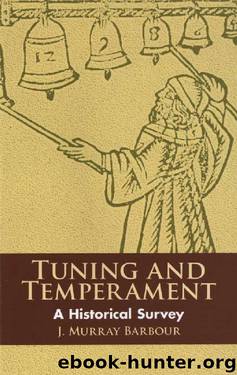Tuning and Temperament: A Historical Survey (Dover Books on Music) by J. Murray Barbour

Author:J. Murray Barbour [Barbour, J. Murray]
Language: eng
Format: epub
Publisher: Dover Publications
Published: 2013-07-04T03:00:00+00:00
Theory of Multiple Division
The reason for the divergent results obtained by these theorists is that each had a different theory regarding acceptable divisions of the octave. Sauveur, although he did list two positive systems, had no real understanding of divisions in which C-Fb could be a major third. To him, the diatonic semitone was the larger: the problem of temperament was to decide upon a definite ratio between the diatonic and chromatic semitones, and that would automatically give a particular division of the octave. If, for example, the ratio is 4:3, there are 5 × 7 + 2 × 4 = 43 parts; if 5:4, there are 5 × 9 + 2 × 5 = 55 parts. We have pointed out above that only the first of these divisions is at all satisfactory. Let us see what the limit of the value of the fifth would be if the (n + l):n series were extended indefinitely. The fifth is (7n + 4)/(12n + 7) octave, and its limit, as n →∞, is 7/12 octave; that is, the fifth of equal temperament. The third, similarly, approaches 1/3 octave. Therefore, the farther the series goes, the better become its fifths, the poorer its thirds. This would seem, then, to be an inferior theory.
In other divisions listed by Sauveur the difference between the two sizes of semitone was two, three, or even four parts. Here, again, the fifth eventually comes close to 7/12 octave and the third to 3/12 octave. Romieu followed Sauveur’s theory. To an extent so did Bosanquet. But the latter added the theory of positive systems. The primary positive system is 17, 29, 41, 53, 65, 77, 89, . . . . Here the fifth can be expressed as (7n + 3)/ (12n + 5) octave. Just as in the negative systems above, the limit of this ratio is 7/12 octave. For the 53- and 65-divisions the fifths are practically perfect; the thirds of these divisions have approximately equal, but opposite, deviations. This suggests a secondary positive system, the mean between the former two: 118, with both fifths and thirds well-nigh perfect. But there is nothing in these series themselves to facilitate choosing the best division or the two best. That had to be ascertained by comparing the intervals in the various divisions after they had been chosen. Again it would seem as if there were an arbitrary factor present.
We have already spoken of Kornerup and his fondness for the 50-division.56 His “golden” system of music was suggested by a study made by P.S. Wedell and N. P. J. Bertelsen in 1915. By the method of least squares they obtained the following octave series in which both the major third (5:4) and the augmented sixth (that is, the minor seventh, 7:4) approach their pure values: 3, 5, 7, 12, 19, 31, 50, 81, 131, 212, 343, . . . . These of course are “golden” numbers, the law of the series being ratio which Kornerup called go. It is this
Download
This site does not store any files on its server. We only index and link to content provided by other sites. Please contact the content providers to delete copyright contents if any and email us, we'll remove relevant links or contents immediately.
| Biographies | Business |
| History & Criticism | Instruments |
| Musical Genres | Recording & Sound |
| Reference | Songbooks |
| Theory, Composition & Performance |
The Goal (Off-Campus #4) by Elle Kennedy(13543)
Kathy Andrews Collection by Kathy Andrews(11728)
Diary of a Player by Brad Paisley(7487)
What Does This Button Do? by Bruce Dickinson(6134)
Assassin’s Fate by Robin Hobb(6127)
Big Little Lies by Liane Moriarty(5699)
Altered Sensations by David Pantalony(5045)
Pale Blue Dot by Carl Sagan(4912)
Sticky Fingers by Joe Hagan(4100)
The Death of the Heart by Elizabeth Bowen(3551)
The Heroin Diaries by Nikki Sixx(3493)
Beneath These Shadows by Meghan March(3261)
Confessions of a Video Vixen by Karrine Steffans(3243)
How Music Works by David Byrne(3186)
The Help by Kathryn Stockett(3082)
Jam by Jam (epub)(3021)
Harry Potter 4 - Harry Potter and The Goblet of Fire by J.K.Rowling(2990)
Strange Fascination: David Bowie: The Definitive Story by David Buckley(2798)
Petty: The Biography by Warren Zanes(2697)
